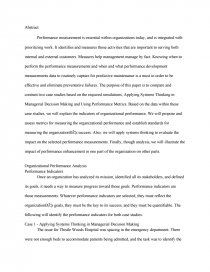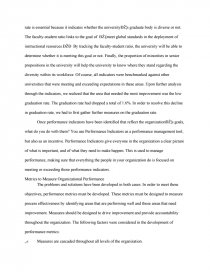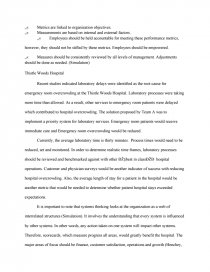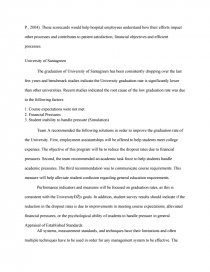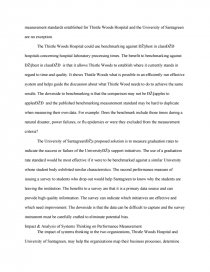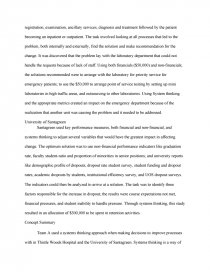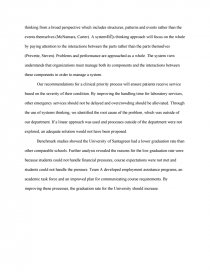Performance Analysis
Essay by review • January 1, 2011 • Book/Movie Report • 2,779 Words (12 Pages) • 2,063 Views
Abstract
Performance measurement is essential within organizations today, and is integrated with prioritizing work. It identifies and measures those activities that are important to serving both internal and external customers. Measures help management manage by fact. Knowing when to perform the performance measurements and when and what performance development measurements data to routinely capture for predictive maintenance is a must in order to be effective and eliminate preventative failures. The purpose of this paper is to compare and contrast two case studies based on the required simulations, Applying Systems Thinking in Managerial Decision Making and Using Performance Metrics. Based on the data within these case studies, we will explain the indicators of organizational performance. We will propose and assess metrics for measuring the organizational performance and establish standards for measuring the organizationÐŽ¦s success. Also, we will apply systems thinking to evaluate the impact on the selected performance measurements. Finally, though analysis, we will illustrate the impact of performance enhancement in one part of the organization on other parts.
Organizational Performance Analysis
Performance Indicators
Once an organization has analyzed its mission, identified all its stakeholders, and defined its goals, it needs a way to measure progress toward those goals. Performance indicators are those measurements. Whatever performance indicators are selected, they must reflect the organizationÐŽ¦s goals, they must be the key to its success, and they must be quantifiable. The following will identify the performance indicators for both case studies:
Case 1 - Applying Systems Thinking in Managerial Decision Making
The issue for Thistle Woods Hospital was spacing in the emergency department. There were not enough beds to accommodate patients being admitted, and the task was to identify the problem area causing the spacing issue. In reviewing the performance of the functions within the hospital, we needed to determine what measures were useful. The indicators were as follows: process flowchart, systems chart, emergency traffic, inpatient traffic, and laboratory traffic. After much data analysis, we came to the conclusion that the problem area was the laboratory process. We found from the indicators that the laboratory traffic was delayed, and patients were not serviced on time. This delay caused a ripple effect on the emergency department resulting in overcrowding and spacing issues. This spacing problem was found to be outside of the emergency department.
In order to rectify this issue, we needed to review the objectives of the organization to determine the measurements needed. ÐŽ§By examining individual measures, indices give you ÐŽÒdrill downÐŽ¦ capabilities to pinpoint problem areasÐŽÐ (Rummler, Brache, Chang, & Morgan, 2003). After review of Thistle WoodÐŽ¦ motto, ÐŽ§Honor, Service, and Commitment,ÐŽÐ we decided to look more into the laboratory processes. As a result we recommended that priority services needed to be arranged within the laboratory for emergency patients. We felt that this would help with limiting the overcrowding in the emergency department. One of Thistle WoodÐŽ¦s goals was ÐŽ§Service,ÐŽÐ so it would necessarily have performance indicators that measure the services within the emergency department and related fiscal measures.
Case 2 - Using Performance Metrics
Measurement involves using the right measures at the right time, especially in measuring organizational performance. If a performance indicator is going to be of any value, there must be a way to accurately define and measure it. For example, ÐŽ§Generate More Repeat CustomersÐŽÐ is useless as a performance indicator without some way to distinguish between new and repeat customers. This simulation audits the process of performances for Santagreen University.
Performance indicators are measurements that define where an organization is and helps to focus on areas that need improvement. In the bi-weekly report on Sacramento region schools, the article states, ÐŽ§The two key indicators have bureaucratic names and confusingly similar abbreviations: Academic Performance Index, or API, and Adequate Yearly Progress, or AYPÐŽÐ (Bee, 2005). These indicators rate the score and help parents to determine how the school is doing. ÐŽ§API is the state of CaliforniaÐŽ¦s measurement of educational achievement. AYP is the yardstick created by the federal government under the No Child Left Behind Act, or NCLBÐŽÐ (Bee, 2005).
The purpose of this simulation was to identify three non-financial performance indicators so that the UniversityÐŽ¦s performances could be tracked. When choosing performance indicators, they should always align with the organizationÐŽ¦s goals and mission. ÐŽ§Be careful of what you measure. What you measure gets done and drives the supplierÐŽ¦s focusÐŽÐ (How to Measure Provider Performances, 2004). The mission of the University is ÐŽ§the pursuit, promotion, and propagation of knowledge through excellence in education processes.ÐŽÐ The goals are to ÐŽ§attract and diversify the graduate student body, meet the global standard with regards to the instructional resources, and promote diversity by abiding by the EEO policy.ÐŽÐ
Many things are measurable, but that does not make them key to the organizationÐŽ¦s success. In selecting performance indicators, it is critical to limit them to those factors that are essential to the organizational goals. In this case, the indicators that best meet the mission and goals of the university are the graduate rate, faculty-student ratio, and proportion of minorities in senior positions in the university.
We believe that the three goals link to the universityÐŽ¦s goals and mission. The graduate rate is essential because it indicates whether the universityÐŽ¦s graduate body is diverse or not. The faculty-student ratio links to the goal of ÐŽ§meet global standards in the deployment of instructional resources.ÐŽÐ By tracking the faculty-student ratio, the university will be able to determine whether it is meeting this goal or not. Finally, the proportion of minorities in senior propositions in the university will help the university to know where they stand regarding the diversity within its workforce. Of course, all indicators were benchmarked against other universities that were meeting and exceeding expectations in these areas. Upon further analysis through the indicators, we realized that the area that needed the most improvement was the
...
...
